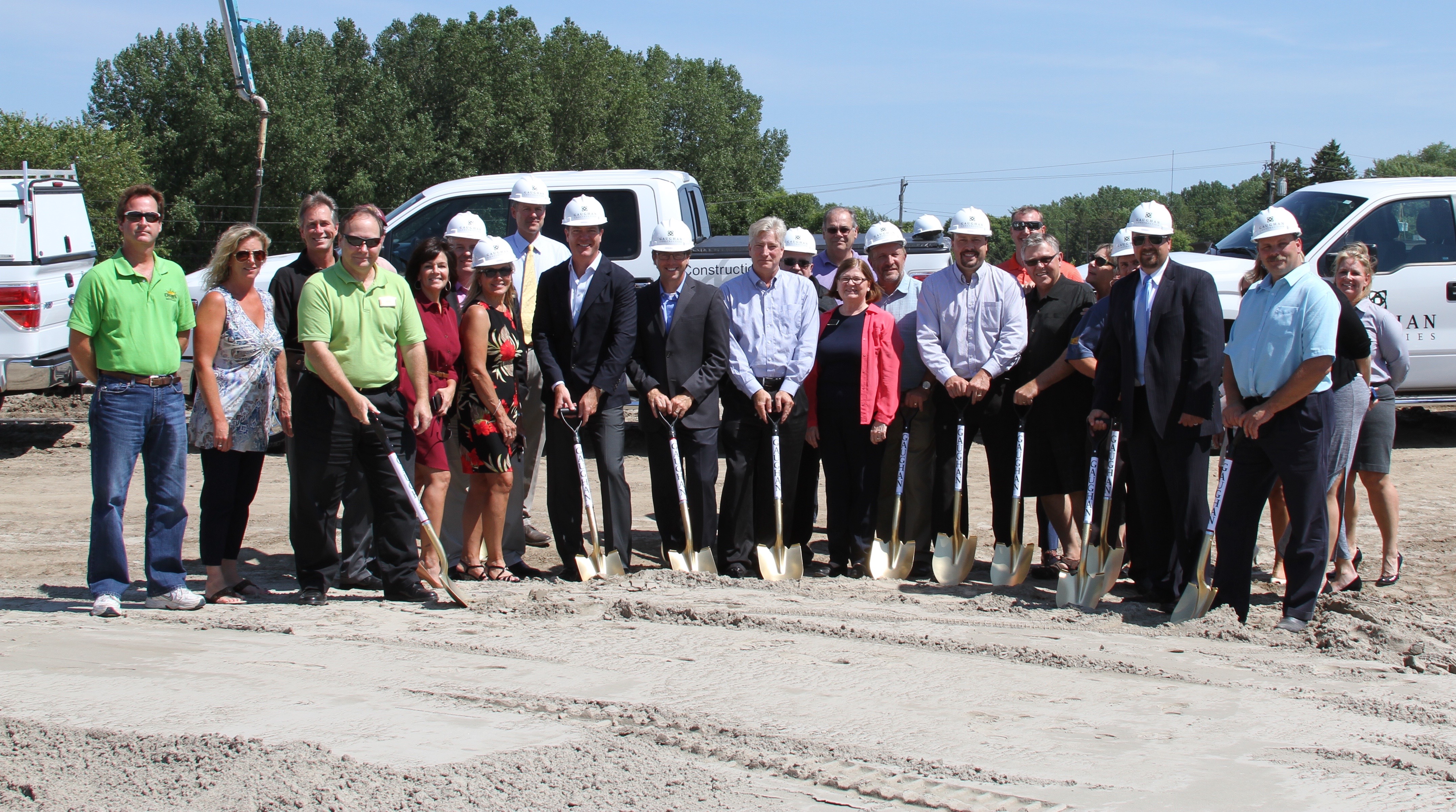The Commercial Construction Process – Part One
Let’s say you are a small business owner and are ready to take your business from a rental unit to your own brick and mortar location. Assuming you have a lot of capital and want to build in an undeveloped location, how do you get started? This is a three-part series that will walk you through the steps.
The first thing to do is to meet with a commercial real estate broker, who will work with you to select just the right spot for your desired business. You should already have an idea of the general size of the building and know how much square footage you will need in order to operate successfully.
If you are purchasing land, then once you find something suitable and enter a contract, you will go through the due diligence stage where a number of items must be checked. One of the first things to do is to have an environmental sample performed. This will check for a variety of important things such as the structural foundation of the land, any chemical or biological waste that may be present, water analysis and air pollution.
As the land is being evaluated, it’s also important to have the title company check for any liens against the property. While this is going on, you will want to check on the neighboring infrastructure. Is your new location zoned for the type of business you want to open? Are other businesses in the area doing well? Is the area growing?
Next, have the property surveyed. This will tell you whether any easements are there and show the legal boundaries that you must operate within. Are any new roads being planned by your city or state government that would cut off access to your property?
Will the location you’ve chosen give you easy access to rails or highways? Will large trucks bearing your supplies be able to get in and out for delivery? Will your customers have an easy time parking, and will you be able to develop special parking to meet the codes established by the American’s with Disabilities Act?
If you’re sure that your new location meets all of the criteria listed above and any other special city or state requirements, then it’s safe to purchase the land.
After the purchase of land, it’s time to hire an architect. This person will be responsible for the general look of your building. It’s fine to suggest building styles or ideas that you like, but remember that this person is the professional and will need to consider the overall function of the building as he or she develops the initial sketches.
A good architect will visit the proposed building site. Then, he or she will use the survey and will also be looking at land measurements in order to render the drawings. At this stage, it will just be an initial design concept. Most architects will provide a set of sketches for you to choose from. These are often referred to as schematic designs. Rough costs are mentioned during this phase.
After you work with the architect to fine tune the design (known as design development), the architect will begin developing it into blueprints. These blueprints (sometimes known as construction documents) are the tools that contractors will use as you move into the bidding process.
Look for part two of our series to continue in a few weeks.
-Dan Hebert
A Day in the Life of a General Contractor
The day starts early for a general contractor. He or she is up before the sun and plans out a schedule for the day. After checking email and grabbing paperwork, he or she is out the door and running.
The typical first stop of the day is the construction site. There the general contractor will meet with the subcontractors and review the progress that they have made since his or her last visit.
The general contractor has already hired several subcontractors through a bidding process. Once a subcontractor is selected, plans and specifications are reviewed to value engineer the project. This ensures the client will receive the best materials and equipment to meet any current and future needs. The general contractor needs to pay particular attention to the project budget during this process.
While the general contractor has several construction sites to manage at once and will be driving all around town, the subcontractors will generally stay on site to supervise their team of workers. Subcontractors typically include carpenters, electricians, plumbers and others.
It is the responsibility of the general contractor and the subcontractors to ensure that the work performed is in accordance with the plans and specifications while following state laws and local building codes. It is also everyone’s responsibility that all work is performed in a safe manor adhering to applicable safety regulations.
After finishing the meeting with the subcontractors, the general contractor may proceed to a mid-morning pre-bid meeting. There he or she will find architects and engineers who have been selected to design new buildings envisioned by a commercial real estate developer.
This commercial real estate developer could be working for the government or a private entity, but he or she has been tasked with building or redesigning an area for future use. He or she has already met with an architect and engineer in order to communicate the ideas of the design.
The architect has spent time preparing plans and specifications and consulting with engineers to make sure that the building design is feasible and follows building codes.
When the general contractor arrives at this meeting, he or she may see other contractors there. They may be gathering there to get information on new developments coming to the area. After having the opportunity to hear about the new project, inspect the site and acquire the plans and specifications, the general contractor will return to the office and begin working on a bid.
The commercial real estate developer or the client will choose the best value bid and award the building rights to that general contractor. Often, the best value bid is not based solely on price but will include other considerations, such as general contractor past experience and project team. The bid usually details the price of labor and materials for the project. Some general contractors take their fee as a percentage of the total building cost. Others may charge a flat fee after considering the project.
When the general contractor returns to the office, he or she has a meeting with his or her assistants to determine the scope of work for the project and what subcontractors need to be contacted to obtain bids. The assistants will then contact subcontractors required for the project to discuss their specific portion of work.
Finally, at the end of the day, the general contractor will make phone calls, order new supplies, interview new subcontractors for upcoming jobs, approve invoices for payment, and review the progress of the bid he or she left the team in charge of.
As the sun is starting to set, the general contractor grabs his or her paperwork and heads for home. Another long but successful day is in the books, and he or she is excited to see the new developments coming to life within the community.
Reducing Waste at the Construction Site
In a recent article on the Demetree Real Estate blog, construction manager Wallace Dostal explained four ways that waste at a construction site can be reduced. Currently, the construction industry produces one-third of landfill waste, according to Dostal. He stresses that planning ahead and putting waste management practices into place will reduce the effect that the industry has on waste production.
We at Gaughan Companies are encouraged by Dostal’s insistence that the waste produced from a construction site can be reduced. We hope that more construction companies will put these practices into place.
You can read more here on the Demetree Real Estate blog.
Top Ten Commercial Real Estate Trends
2016 is showing great promise in both updating commercial real estate trends, and adding new ones. The following are things to watch for this year:
1. Overseas Investment into U.S. Commercial Real Estate
The U.S. property market is among the most stable and transparent in the world. With growth slowing in Europe and China, foreign investors are flocking to back U.S. projects. According to the Commercial Real Estate Development Association, $91.1 billion was spent by overseas investors on U.S. transactions in 2015. That accounts for 17 percent of all deals. Most of the investors are from Canada. Since that country is lacking in dense populations and has limited resource investment, their citizens’ view the U.S. as a lucrative way to leverage their buying power.
2. Global Urbanization and Its Reverse
Millennials and Baby Boomers have something in common. They both want to seek out living space in metro areas. As they move away from the suburbs, they are looking for affordable units to rent or purchase. In addition, they need to find places to buy their groceries, get some exercise, and shop for household items and apparel.
Generation X and Millennials with children, however, are either staying in or moving to the suburbs. Promises of more house for the money, large green lawns and local parks and playgrounds are drawing them out. Once they relocate to the suburbs, they also need to get groceries, find places to exercise, and shop for household items and apparel.
Commercial real estate has an edge in both urban and suburban areas as builders try to meet the demands of bringing grocery stores, parks, gyms, recreation sites, and houses of worship, coffee shops, bookstores, and more to the market.
3. New Commercial Construction will be More Limited
Building new multi-family dwellings is diminishing. However, the need for senior and student housing is increasing. As these demographics look for affordable housing, they are considering new options such as the tiny house movement. In addition, cities are taking old abandoned big box stores and malls and are re-purposing them for uses that better fit this day and age. Gyms, recreation facilities, and even government offices now sit where old eyesores used to reside. The city leaders realize that often it’s much more cost-effective to remodel an existing structure, rather than invest in new construction.
4. Tearing Down Parking Lots and Garages
As metro consumers get used to using mass transit, more and more of them are ditching their autos and relying on goods and services that can be obtained through delivery or by walking directly to the retailers. They seek communities that are made up of mixed use dwellings, such as having a retailer on the bottom floor, and housing on the top floors. In addition, green space has become very important for city dwellers. They want a place to play with their kids, walk the dog, bicycle and roller skate. Since land space is limited, parking lots and garages are often torn down in order to make room for more buildings.
5. Increasing Stress on Retailers
The average consumer is having to pay more these days to use their credit card, and merchant processing fees are higher too. Reports suggest that on-line sales have triumphed over in-person sales, especially around Thanksgiving weekend. In order to combat this trend, retailers will have to create virtual shopping that combines with physical shopping. Major retailers are already being threatened by discount stores that carry quality, off-brand merchandise. Almost monthly, we hear about large companies such as Macy’s, K-Mart, and JC Penney that are closing stores. However, it seems that chain restaurants are expanding. Commercial real estate experts need to move quickly to fill those properties that have been abandoned.
6. Rising Interest Rates
If the Federal Reserve continues to raise the interest rates, the market will become more stable. However, it will also rule out the small business person who has dreamed of opening a small brick and mortar store. According to the Small Business Administration, small business owners own or lease between 30 and 50 percent of all commercial real estate space in the U.S. However, if these entrepreneurs and franchises can’t afford the rent, these properties will remain vacant.
7. Drop in Energy Prices
The price of oil has dropped several times this year. This draws consumers out of their homes, and encourages them to travel. Hotels, restaurants, attractions and city tourism benefit because they are hosting more guests. As for running businesses, consumers are seeing more profit in part, because their heating and air conditioning bills are dropping. This gives additional buying power, and they tend to want to go out to enjoy their surroundings more. This affects commercial real estate experts because they need to be sensitive to those establishments that are ready to add on to their existing properties.
8. Changes in Office Landscape
Americans are seeing change come to their workplace. Several companies support telecommuting. Others support desk-sharing. It seems that the bigger companies such as AT&T are doing away with the cubicles of yesterday, and are instead embracing a collaborative work space environment. Huddle rooms, quad shaped desk rounds that hold 4-5 workers, and a lack of dividing walls and walkways have become the norm. Commercial developers are watching this new trend, and need to be quick to respond with proposals for interior remodeling.
9. The Introduction of LEED
Along with the new trends in the workplace environment, companies are embracing “going green.” They are installing energy efficient thermostats, and water savings devices that will cut down on their carbon footprint. They are also trying to continue to go paperless and rely on a digital environment.
LEED stands for Leadership in Energy and Environmental Design. It uses 3rd party verification to verify that a building is “green.” In addition, companies are installing green space inside of buildings, and planting vegetation. Commercial real estate companies need to understand this trend and be ready to respond with sub-contractors that are knowledgeable in these fields.
10. The Advancement of the Internet of Things
Pretty soon, getting to the office, turning on the lights and heating up the coffee maker will be things of the past. With the internet of things, more and more “smart buildings” are being created. Special wiring will interface with digital technology to make the life of the consumer even easier. A worker will be able to turn on the lights in the office, start the coffee maker, and pan the security cameras from the comfort of his home. If he does decide to go into the office, he can remote in to his kid’s daycare, start the oven or the crock-pot at his home, and start his car, all from the touch of button.
As commercial real estate companies continue to study this trend, they need to be able to respond by having sub-contractors who are well versed in creating apps that allow building managers to remotely control the building resources and respond to requests to restock or send janitorial services on demand.
The world and its resources are changing around us every day. We, as commercial real estate industry professionals, along with our partners, are developing plans to meet and stay ahead of these trends and demands. We aspire to be the new leaders on the information superhighway and community advancements of tomorrow.
Gaughan Companies Partners with Non-Profit Community Changing Thrift Store
Gaughan Companies recently broke ground on the new Family Pathways North Branch thrift store. It will be located on Tanger Drive between the Nike outlet and the North Branch Cinema Theater.
This building is the first stand-alone building for Family Pathways and will serve as North Branch’s local thrift store as it partners with ten other locations in serving our community.
As president of Forest Lake, Minnesota-based Gaughan Companies, Patrick Gaughan said, “It’s fun to be a part of this kind of deal. It means a lot to the city. It brings jobs to the community. So all transactions, big or small, are important.”
Family Pathways is a fast growing non-profit thrift store in East Central Minnesota and Polk County Wisconsin. Proceeds from the thrift store sales go toward community programs that the organization sponsors.
These include Hunger Relief, The Refuge Network Domestic Abuse Programs and Shelter, Aging Services, and Youth Programs.
The mission of Family Pathways is to work with communities to develop supportive, caring relationships to help people meet their basic needs.
Last year saw the organization bring a new quality of life to hurting families by proving food for nearly 19,000 people, assisting in refuge from domestic violence for nearly 2400 victims, and assisting nearly 7500 senior citizens with the means to start or continue independent living.
Gaughan Companies is pleased to partner with this trusted organization and is excited to announce that the opening of this thrift store is on schedule for early 2017. For more information, please visit Gaughancompanies.com, and Familypathways.org.
Gaughan Completes Phase Two of City Center Commons
Gaughan Companies announces the completion of its latest development project called City Center Commons, located along highway 61 on the south side of Forest Lake. The new commercial buildings provide a clean, modern look and feel to the community.
The building will occupy several tenants including Keller Williams in one building, along with Thrifty White and Maplewood Oral Surgery in the second building. There is one additional space available for custom build-out which has the potential for a new franchise restaurant.
“We’re adding residential rooftops to the Minneapolis suburbs again and demand for more commercial and retail space is imminent based on the region’s population growth,” said Patrick Gaughan, in reference to the return of growth in the economy after a post-recession lull.
Gaughan Construction continues to embrace the growth of the economy and the future of the company.
Minnesota Construction Industry on the Rise?
In April of 2016, Minnesota added 7,400 employment opportunities with great thanks to the development and construction industries. Statistics indicate a solid increase in development projects throughout Minnesota over the past several months. The construction industry is currently booming with this month having the largest increase in production within the past 25 years. These factors attribute to Minnesota’s lowering unemployment rate which is now approximately 3.7%, and a 1.7% increase in job growth over the past year. Specifically in the Minneapolis and St. Paul region, employment growth increased by 1.8%. These trends help to provide a positive outlook for what the future of construction may hold.
There’s Magic in a Mission

When my leadership team and I were determining our Mission Statement, it was important to us that we not only convey what we do, but that we care about our clients.
Our Mission Statement is simple but not simplistic:
“We care for people’s real estate interests through Construction, Brokerage, Development, Management and Maintenance.”
Real estate is where life happens, where business is conducted or a family resides. We do not just care for the real estate, we care for the real people who occupy those places.
Our Mission Statement not only says what we do, but it keeps our team laser focused on our purpose and commitment to our clients, which is where the magic really happens!
In the article below my good friend and business colleague Chris Naylor talks about the importance of having a Mission Statement in her blog ‘There’s Magic in a Mission!’ I am confident that if you have not already found your mission this article will give you direction on where to start!
Patrick Gaughan
Gaughan Construction Celebrates Ground Breaking of City Center Commons Project
Gaughan Construction broke ground on a new 2 building office medical project in Forest Lake. The new City Center Commons project is the first “ground up” construction project that Gaughan Construction has developed in recent years. City Center Commons is located along highway 61 adjacent to the recently built Forest Lake City Center Building, The project is scheduled for completion Q4 2015 into Q1 2016. City Center Commons has signed leases with Keller Williams, which will be the sole occupant for the 8,000 sf building. Maplewood Oral Maxillofacial Surgery and Thrifty White will anchor the adjacent 11,000 sf building. Negotiations are in the works for the remaining square footage for the 11,000 building.
“This is a great project for the City of Forest Lake and the community. We are proud to be developing this project and look forward to provide good quality space for tenants.” – Dan Hebert – VP of Commercial Accounts – Gaughan Companies
A solid foundation since 1969, Gaughan Companies provides the Twin Cities area with a full service commercial real estate company. We deliver consistent performance through unparalleled professionalism and personal service. Visit our website at www.gaughancompanies.com for more information.
Gaughan Companies to Host New Tech Forward Eatery
When you think burgers, fries and shakes, you probably don’t think high tech service. One of Gaughan’s newest tenants is looking to change all that with Diggity’s Drive Up.
On paper, Diggity’s is your classic burger shack served with a heaping helping of Americana. Unlike the drive ups of yesterday, you won’t find any rollerskating candy stripers whisking away orders to hungry patrons. In fact, you won’t find any servers at all.
Read More







